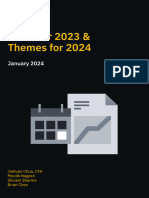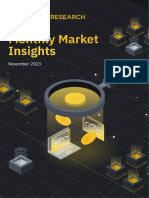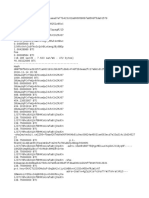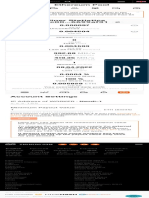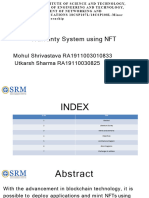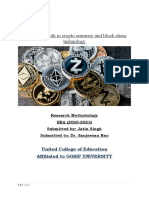State of Crypto 2024 - a16z crypto
a16zcrypto.com/posts/article/state-of-crypto-report-2024
October 16, 2024
Table of contents
7 key takeaways
1. Crypto activity and usage hit all-time highs
2. Crypto has become a key political issue ahead of the U.S. election
3. Stablecoins have found product-market fit
4. Infrastructure improvements have increased capacity and drastically reduced
transactions costs
5. DeFi remains popular — and it’s growing
6. Crypto could solve some of AI’s most pressing challenges
7. More scalable infrastructure has unlocked new onchain applications
When we launched our first annual State of Crypto report two years ago, the world looked
very different. Crypto wasn’t high on policymakers’ agendas. Bitcoin and Ether exchange-
traded products (ETPs) weren’t yet SEC approved. Ethereum had not yet switched to
energy-minimizing proof-of-stake. Layer two (L2) networks, designed to increase capacity
and lower transaction costs, were largely inactive — and the transactions that did occur
on them cost a lot more than they do today.
Times have changed, as our newly released 2024 State of Crypto Report makes clear.
Our report covers crypto’s rise as a hot policy topic, the many recent tech improvements
to blockchain networks, and the latest trends among crypto’s builders and users. The
report also:
1/24
� digs into the emergence of key applications such as stablecoins — one of crypto’s
“killer apps”;
explores the intersection of crypto and other key tech trends like AI, social networks,
and games;
shares new data on swing states’ levels of crypto interest ahead of the U.S.
election, and more.
The 2024 State of Crypto report also reveals all-time highs in crypto activity. And it
analyzes how blockchain infrastructure has matured — especially after recent scaling
upgrades drastically decreased onchain transaction costs alongside the rise of Ethereum
L2s and other high-throughput blockchains.
This year, we’re also introducing a new tool: the a16z crypto Builder Energy dashboard.
For the first time ever, we’re sharing proprietary data based on our unique view of the
crypto landscape, including where the “builder energy” is. The dashboard incorporates
thousands of data points — aggregated and anonymized — that are drawn from
investment team research, our CSX startup accelerator program, and other industry-wide
tracking. Through this tool, anyone can explore what crypto builders are saying about
their activity and interests — everything from which blockchains they’re building on, to
what types of applications they’re building, as well as which technologies they’re building
with, and where they’re based. We plan to update the data every year as part of our
annual State of Crypto.
explore the dashboard
Now for the findings from our 2024 State of Crypto report.
7 key takeaways
Crypto activity and usage hit all-time highs
Crypto has become a key political issue ahead of the U.S. election
Stablecoins have found product-market fit
Infrastructure improvements have increased capacity and drastically reduced
transaction costs
DeFi remains popular — and it’s growing
Crypto could solve some of AI’s most pressing challenges
More scalable infrastructure has unlocked new onchain applications
1. Crypto activity and usage hit all-time highs
There have never been more monthly active crypto addresses. In September, 220 million
addresses interacted with a blockchain at least once, a figure that has more than tripled
since the end of 2023. (As a metric, active addresses are easier to game than other
measures. See more on that point here.)
2/24
�The explosion of activity is primarily due to Solana, which accounted for about 100 million
active addresses. Following were NEAR (with 31 million active addresses), Coinbase’s
popular L2 network Base (22 million), Tron (14 million), and Bitcoin (11 million). Of
Ethereum Virtual Machine (EVM) chains, the second-most active after Base was
Binance’s BNB Chain (10 million), followed by Ethereum (6 million). (Note: EVM chains
were de-deduplicated by public key to calculate the 220 million total.)
These trends are also reflected in our Builder Energy dashboard. The blockchain that saw
the biggest change in total share of builder interest is Solana. Specifically, the total share
of founders who told us they either are, or are interested in, building on Solana grew to
3/24
�11.2% this year from 5.1% last year. Base saw the next biggest jump, its total share
growing to 10.7% from 7.8% last year, followed by Bitcoin, which bumped to a total share
of 4.2% from 2.6% last year.
On an absolute basis, Ethereum is still attracting the greatest share of total builder
interest at 20.8%, followed by Solana and Base. After that are Polygon (7.9%), Optimism
(6.7%), Arbitrum (6.2%), Avalanche (4.2%), Bitcoin (4.2%), and so on.
Meanwhile, the number of monthly mobile crypto wallet users hit an all-time high of 29
million in June 2024. While the U.S. makes up the greatest share of monthly mobile wallet
users at 12%, its share of the total mobile wallet user base has declined in recent years
as crypto adoption grows globally and as more projects seek regulatory compliance by
excluding the U.S. through geofencing.
4/24
�Crypto’s footprint continues to expand abroad. After the U.S., the countries with the
greatest share of mobile wallet users include Nigeria (which has sought to provide
regulatory clarity including through regulatory incubation programs and has seen
significant growth in consumer uses such as bill payments and retail purchases), India
(with its booming population and mobile phone adoption), and Argentina (where many
residents have flocked to crypto — especially stablecoins — amid currency devaluation).
While it’s easy to measure active addresses and monthly mobile wallet users, it’s much
trickier to measure the number of actual active crypto users. However, using a
combination of methodological approaches, we’ve estimated that there are 30-to-60
million monthly active crypto users worldwide, a proportion that represents only 5–10% of
the total number of the 617 million global crypto owners estimated by Crypto.com in June
2024. (For more on the methodology behind our estimate, see here.)
5/24
�The disparity underscores the large opportunity to engage — and re-engage — passive
crypto holders. As major infrastructure improvements make brand new, compelling apps
and consumer experiences possible, more dormant crypto holders could become active
onchain users.
2. Crypto has become a key political issue ahead of the U.S.
election
Crypto has broken into the national discourse this election cycle.
So we measured swing states’ relative levels of crypto interest. Two battlegrounds
expected to be among the tightest races in November — Pennsylvania and Wisconsin —
have seen the fourth- and fifth-biggest jumps in crypto search interest since the last
election in 2020, measured as a proportion of total searches using Google Trends.
Michigan saw the eighth-biggest jump in crypto search interest, while Georgia stayed put.
Meanwhile, Arizona and Nevada experienced moderate drops in interest since 2020.
6/24
�One factor that could have raised people’s crypto interest this year was the listing of
Bitcoin and Ethereum exchange-traded products (ETPs). The number of Americans who
hold crypto could grow as ETPs such as these broaden investor access. Together, the
Bitcoin and Ethereum ETPs already contain $65 billion in onchain holdings. (Note:
Though commonly called ETFs, these products are actually registered as ETPs using
SEC Form S-1, indicating the underlying portfolios are not comprised of securities.)
The SEC’s ETP approvals represent major crypto policy milestones. Regardless of which
party wins office in November, many politicians expect momentum to build with the
passage of bipartisan crypto legislation. An increasing number of policymakers and
politicians are speaking positively about crypto on both sides of the aisle.
7/24
�The industry has inspired other significant movements on the policy front this year as
well. At the federal level, the House of Representatives approved the Financial Innovation
and Technology for the 21st Century (FIT21) Act with bipartisan support, including 208
Republicans and 71 Democrats voting in favor. Pending Senate proceedings and
approval, the bill could provide much-needed regulatory clarity to crypto entrepreneurs.
No less meaningfully, at the state level, Wyoming passed the Decentralized
Unincorporated Nonprofit Association (DUNA) Act, a law that gives decentralized
autonomous organizations (DAOs) legal recognition and enables blockchain networks to
operate lawfully without compromising on decentralization.
8/24
�The EU and the United Kingdom have been the most proactive in engaging the public on
questions of crypto policy and regulation. Various European agencies have put out many
more calls for input than, for example, the U.S. Securities and Exchange Commission.
Meanwhile, the European Union’s Markets in Crypto Act (MiCA) is the first
comprehensive crypto-related policy regime to pass into law and it is set to come into full
effect by the end of the year.
Stablecoins — which have become one of the most popular crypto products — are one of
the biggest topics for policy discussion, with several bills already floating around
Congress. One of the tailwinds, at least in the U.S., is the realization that stablecoins can
fortify the U.S. dollar’s position abroad even as the dollar’s global reserve currency status
slips. Today, more than 99% of stablecoins are denominated in USD, which dwarfs the
next largest denomination: 0.20% in Euro.
9/24
�In addition to projecting the power of the American dollar around the world, stablecoins
are potentially strengthening the country’s financial footing at home. Despite being only a
decade old, stablecoins have risen to become a top 20 holder of U.S. debt, putting them
ahead of countries like Germany.
While some countries are exploring central bank digital currencies (CBDCs), the
stablecoin opportunity sitting right in front of the U.S. is ripe for the taking. Between these
discussions and the number of prominent political figures now weighing in about crypto
generally, we expect more countries will start to flesh out their crypto policies and
strategies in earnest.
10/24
�3. Stablecoins have found product-market fit
By enabling fast, cheap, global payments, among other uses, stablecoins have become
one of crypto’s most obvious “killer apps”. Indeed, as Rep. Ritchie Torres (D-N.Y.) wrote in
September in a New York Daily News op-ed, “The proliferation of dollar stablecoins —
rendered possible by the ubiquity of smartphones and the cryptography of blockchains —
could become the greatest experiment in financial empowerment humanity has ever
undertaken.”
Major scaling upgrades have drastically reduced the cost to execute crypto transactions,
including those involving stablecoins, in some cases by over 99%. On Ethereum,
transactions involving USDC, a popular U.S. dollar-pegged stablecoin, cost on average
$1 in gas fees this month, down from $12 on average in 2021. Sending USDC on Base,
Coinbase’s popular L2 network, costs less than a cent on average. (Note that these
figures may exclude some onboarding and exit costs.)
Compare these fees to the $44 on average that it costs to send an international wire
transfer.
Stablecoins make it easy to transfer value. They amounted to $8.5 trillion in transaction
volume across 1.1 billion transactions in the second quarter of 2024 ended June 30.
Stablecoin transaction volumes more than doubled Visa’s $3.9 trillion in transactions over
the same period. That stablecoins have entered the same conversation as such well-
known and entrenched payment services as Visa, PayPal, ACH, and Fedwire is a
remarkable testament to their utility.
11/24
�Stablecoins aren’t just a fad either. If you compare stablecoin activity against crypto’s
volatile market cycles, the two appear to be uncorrelated. Indeed, the number of monthly
stablecoin-sending addresses has continued to increase even as spot crypto trading
volumes have declined. In other words, people appear to be using stablecoins for more
than just trading.
All that activity is reflected in usage stats. Stablecoins represent nearly a third of daily
crypto usage at 32%, second only to decentralized finance, or DeFi, at 34%, as measured
by share of daily active addresses. The rest of crypto’s usage is spread across
infrastructure (bridges, oracles, maximum extractable value, account abstraction, etc.),
token transfers, and a smattering of other areas, including emerging applications such as
gaming, NFTs, and social networking.
12/24
�4. Infrastructure improvements have increased capacity and
drastically reduced transactions costs
One reason why stablecoins have gotten so popular and easy to use is due to underlying
infrastructure advances. For one thing, blockchain capacity is growing. Blockchains are
processing more than 50 times as many transactions per second as they were just four
years ago thanks to the rise of Ethereum L2 networks and other high-throughput
blockchains.
13/24
�More staggeringly, Ethereum’s biggest upgrade of the year — “Dencun,” also called
“protodanksharding” or EIP-4844 — significantly reduced fees for L2 networks after its
implementation in March 2024. Since then, the fees paid by L2s on Ethereum have
plummeted even as ETH-denominated value on L2s has continued to rise. In other
words, blockchain networks are getting more popular — and more efficient — all at once.
It’s a similar story for zero knowledge (ZK) proofs, another technology that has important
implications for blockchain scaling, privacy, and interoperability. Even as the amount
spent monthly to verify ZK proofs on Ethereum has declined, ETH-denominated value on
ZK rollups has increased. In other words, ZK proofs are getting cheaper, too, even as
they’re getting more popular. (We use zero knowledge here as a catchall for cryptography
that can succinctly prove that computations offloaded to rollup networks were performed
correctly.)
14/24
�ZK technology is extremely promising as it opens new pathways to cheap, verifiable
blockchain compute for developers. Still, ZK-based virtual machines (zkVMs) have a long
way to go before they can catch up to the performance of traditional computers — a
humbling observation to note.
With all of these infrastructure improvements, it’s easy to see why blockchain
infrastructure remains one of the most popular categories for builders and why L2s have
become one of the top 5 hottest builder subcategories that we’re tracking.
15/24
�5. DeFi remains popular — and it’s growing
The only category attracting builders more than blockchain infrastructure is decentralized
finance, or DeFi (which also accounts for the most crypto usage at 34% of daily active
addresses). Since DeFi’s arrival in the summer of 2020, decentralized exchanges, or
DEXs, have grown to account for 10% of spot crypto trading activity — all of which
occurred on centralized exchanges just four years ago.
More than $169 billion is now locked inside thousands of DeFi protocols. Some of the top
DeFi subcategories involve staking and lending.
16/24
�It’s been just over two years since Ethereum completed its transition to proof-of-stake,
drastically reducing the network’s energy consumption and environmental footprint. Since
then, the share of Ether being staked has risen to 29%, up from 11% two years prior,
greatly enhancing the security of the network.
While still in its early stages, DeFi presents a hopeful alternative to the trend of
centralization and power consolidation afflicting the U.S. financial system, where the
number of banks has dropped by two-thirds since 1990 and where an increasingly small
share of big banks dominate assets.
17/24
�6. Crypto could solve some of AI’s most pressing challenges
AI is one of the hottest trends this year, not only in tech broadly, but also in crypto
specifically.
AI is one of the most talked about trends among crypto influencers on social media.
Perhaps more surprisingly, there’s major overlap between visitors to chatgpt.com and
visitors to top crypto websites, indicating strong ties between crypto and AI users.
Crypto builders also have strong ties to AI. About a third of crypto projects — 34% — say
they’re using AI, regardless of the category in which they’re building, up from 27% a year
ago, per our Builder Energy dashboard. The most popular category for applied AI tech is
18/24
�blockchain infrastructure projects.
Given that the cost of training frontier AI models has increased at four-times per year over
the past 10 years, we believe AI could trend toward increasing centralization of power on
the internet. Left unchecked, only the biggest tech companies may have the resources to
train the latest AI models.
AI’s centralization-related challenges are almost exactly the inverse of the opportunities
for decentralization presented by blockchain networks. Crypto projects are already
attempting to tackle some of these challenges today, including Gensyn (by democratizing
19/24
�access to AI compute), Story (by tracking IP to help compensate creators), Near (by
running AI on open source, user-owned protocols), and Starling Labs (by helping to verify
the authenticity and provenance of digital media), to name a few.
The crossovers between crypto x AI may strengthen in the years ahead.
7. More scalable infrastructure has unlocked new onchain
applications
As transaction costs come down and blockchain capacity goes up, many other potential
crypto consumer apps become possible.
Take NFTs, for instance. When crypto transactions were much more expensive a few
years ago, people were trading NFTs on secondary markets for large sums totaling
billions of dollars. That activity has since subsided, and in its place has risen a new
consumer behavior: minting low-cost NFT collections on social apps like Zora and Rodeo.
This represents a significant shift for the NFT market, one that was largely inconceivable
before a drastic reduction in transaction fees.
20/24
�Social networks are another example. Even though they account for only a small portion
of daily onchain activity today, they’re attracting strong builder activity: 10.3% of crypto
projects are social-related in 2024, per our Builder Energy dashboard. In fact, social
network-related projects, such as those related to Farcaster, are one of the top 5 hottest
builder subcategories this year.
While builders and consumers explore more social experiences, onchain games are
pushing blockchain scaling to its limits. Rollups such as those used by Proof Of Play’s
high-seas adventure role playing game Pirate Nation are consistently using the most gas
per second of any Ethereum rollups.
21/24
�As the November election approaches, crypto-based prediction markets are having a
moment — despite their illegality in the U.S. — and momentum is building for prediction
markets in general. So much so that Kalshi, a non-crypto-based prediction market that’s
registered with the U.S. Commodity Futures Trading Commission, gained a win in a lower
court last month as it pursues a federal lawsuit around listing elections contracts. (As of
now, registered exchanges are allowed to offer elections-based traditional futures
contracts.)
Glimmers of novel consumer behaviors are beginning to be discernible. All these new and
emerging experiences were intractable when blockchain infrastructure was clunkier and
transaction costs were higher. As the blockchains improve along classic tech price-
performance curves, expect more of these applications to thrive.
22/24
�***
Where does that leave us? The state of crypto has made significant strides across policy,
technology, consumer adoption, and more over the past year. There were policy
milestones, including the sudden approval and listing of Bitcoin and Ethereum ETPs, as
well as the passage of significant bipartisan crypto legislation. There were major
infrastructure improvements, from scaling upgrades to the rise of Ethereum L2s and other
high-throughput blockchains. And there were new apps being built and used, from the
growth of mainstays like stablecoins to explorations of more nascent categories like AI,
social networking, and games.
Whether we have entered the fifth wave of the price-innovation cycle, our framework for
understanding the ups and downs of crypto’s many market cycles, remains to be seen.
Either way, crypto, as an industry, has made inarguable progress over the past year. And
as ChatGPT has proven, it can take just one breakout product to shift an entire industry.
***
Sign up for a16z crypto’s biweekly newsletter here. And for more regular data updates,
keep an eye on our State of Crypto Index, an interactive tool, updated monthly, that tracks
the health of the crypto industry from a technological, rather than financial, perspective
through measures of industry rates of innovation and adoption. Also be sure to explore
our new Builder Energy dashboard, which tracks where we’re seeing the most “builder
energy” across crypto.
***
The views expressed here are those of the individual AH Capital Management, L.L.C.
(“a16z”) personnel quoted and are not the views of a16z or its affiliates. Certain
information contained in here has been obtained from third-party sources, including from
portfolio companies of funds managed by a16z. While taken from sources believed to be
23/24
�reliable, a16z has not independently verified such information and makes no
representations about the current or enduring accuracy of the information or its
appropriateness for a given situation. In addition, this content may include third-party
advertisements; a16z has not reviewed such advertisements and does not endorse any
advertising content contained therein.
This content is provided for informational purposes only, and should not be relied upon as
legal, business, investment, or tax advice. You should consult your own advisers as to
those matters. References to any securities or digital assets are for illustrative purposes
only, and do not constitute an investment recommendation or offer to provide investment
advisory services. Furthermore, this content is not directed at nor intended for use by any
investors or prospective investors, and may not under any circumstances be relied upon
when making a decision to invest in any fund managed by a16z. (An offering to invest in
an a16z fund will be made only by the private placement memorandum, subscription
agreement, and other relevant documentation of any such fund and should be read in
their entirety.) Any investments or portfolio companies mentioned, referred to, or
described are not representative of all investments in vehicles managed by a16z, and
there can be no assurance that the investments will be profitable or that other
investments made in the future will have similar characteristics or results. A list of
investments made by funds managed by Andreessen Horowitz (excluding investments for
which the issuer has not provided permission for a16z to disclose publicly as well as
unannounced investments in publicly traded digital assets) is available at
https://a16z.com/investment-list/.
Charts and graphs provided within are for informational purposes solely and should not
be relied upon when making any investment decision. Past performance is not indicative
of future results. The content speaks only as of the date indicated. Any projections,
estimates, forecasts, targets, prospects, and/or opinions expressed in these materials are
subject to change without notice and may differ or be contrary to opinions expressed by
others. Please see https://a16z.com/disclosures/ for additional important information.
24/24










